Ecological Study: Stepping Up Pack
Area
I conducted my study in and around Mere Knolls Cemetery and Seaburn Dene. I chose this piece of land as my area of study because the effects of humanity and nature are both prominent in this area, and so it would provide good points of discussion in this ecological study.
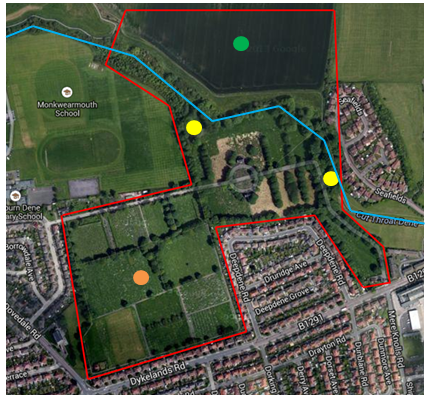
The area I studied is highlighted by the red outline. As you can see, there is a variety of different types of land within and around the cemetery, such as the farmland (highlighted by the green circle), the areas of dense plant life (highlighted by the yellow circles) and fields that are regularly cut (highlighted by the orange circle). There is a small stream called “Cut Throat Dene” or colloquially known as “Seaburn Dene” that runs through the cemetery towards the nearby sea front (highlighted by the blue line).
The variety of different biomes in this area is what attracted me to conduct my ecological study there, as I predicted that there would be many different species of animals and plants to survey. I also chose it so that I could compare and contrast my results from the different areas, to see to what extent human and natural factors have affected the diversity of organisms in the area.
Obviously, the picture above (courtesy of Google Maps), was not taken on the same day in which I conducted my study. The main noticeable difference from that picture to when I conducted my study is that the farmland was growing a crop of barley (shown to the right). The only other difference may be the season, as I conducted my study late July, and the time of year the photo was taken is unknown.
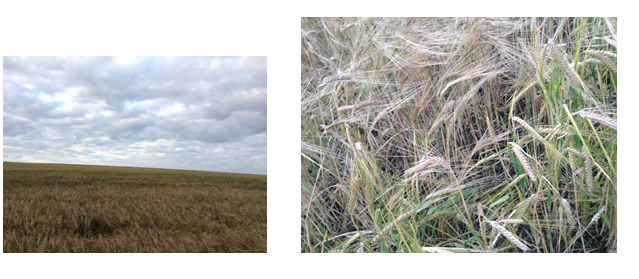
Method and Findings
The method I used for counting the different species I encountered was by making a tally chart. This allowed me to swiftly count the organisms without losing count. To identify the organisms, I took photos of at least one example of each organism, and then used the internet to identify the exact species if I did not already know what they were. Although this may not have been the most analytical way to carry out the investigation, it worked fine and was enough for me to gain results from my study.
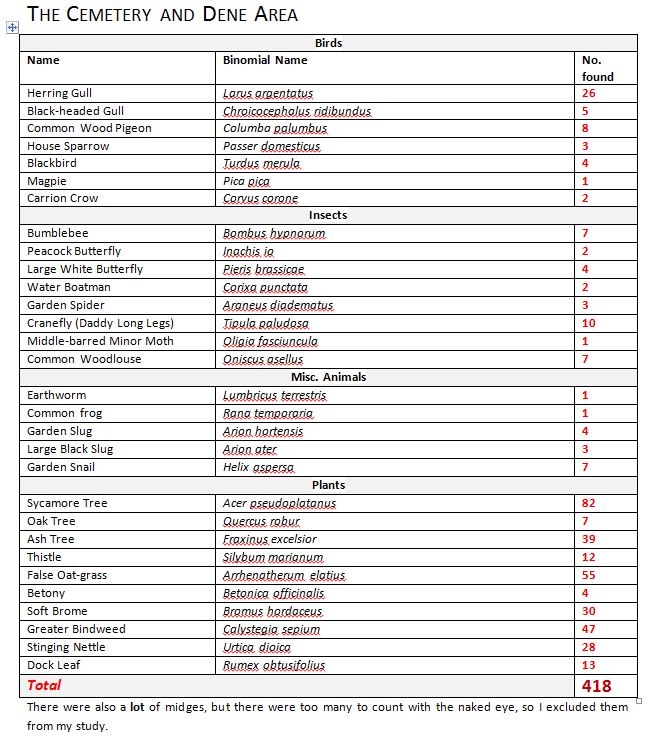
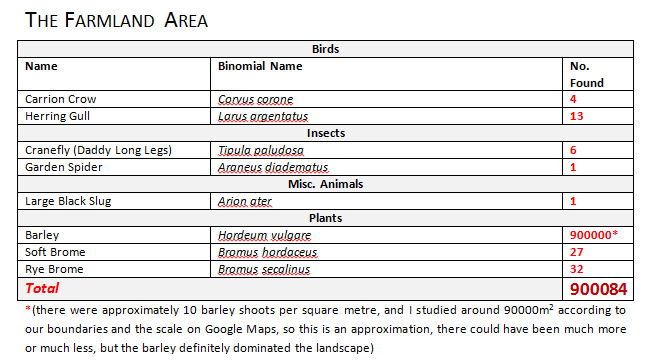
As you can see before any proof by calculation, there are many more different organisms that live or pass through the cemetery as opposed to the farmland. From the assumption, you can estimate that the index of diversity for the cemetery and dene area will be greater than that of the farmland area. Although there is a huge amount of plants in the farmland area, it is predominantly one species. This species was able to thrive in its conditions as all competition from other plants has been removed (apart from some wild, tall grass) artificially, in order for the farmer to increase the yield of his crop and make more profit.
Calculations
Formula for calculating the Index of Diversity:
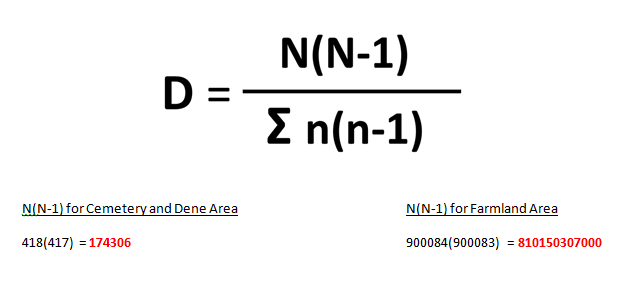

The calculations support the prediction I made earlier; the cemetery and dene have a higher index of diversity than the farmland. I will expand upon these points in explanation later in this report.
Interactions and Relationships of Organisms
The different organisms that belong to an ecosystem play a role that is usually beneficial to that ecosystem’s survival. This role is called a niche, and involves when, where and what the organism feeds on. Every species has a niche in a given ecosystem. For example, honeybees pollenate flowering plants, allowing the plants to reproduce. If the honeybee was not present, the plants would not be pollenated and would not be able to reproduce, creating a decline in the number of plants.

Fungus is a eukaryotic organism that decomposes organic waste and feeds the plants around them with these nutrients from the decomposition. I found several different types of fungi in my study, but was unable to successfully identify them using the internet, so I excluded them from my results. I found a lot of fungi on dead and rotting tree stumps, as you would expect. The fungi on these dead tree remains will be feeding on the dead organic matter from the tree, recycling the nutrients found in the tree for new plants to use in their growth. This allows plants to grow from the dying tree, as seen to the left. The niche of fungi in this ecosystem is mutualistic – both the plants and the fungi benefit from the relationship. The fungi recycle nutrients from the dead tree bark, and then provide this to plant life around them. I also noticed fungi on the roots of plants. This is another mutually beneficial relationship; the fungi gives the plant nitrogenous compounds, phosphate and other ions, while the plant provides carbohydrates for the fungi.
Another example of mutualism present in the ecosystem I studied was pollination. The bumblebees and butterflies feed on the nectar and pollen found within the flowers of plants in the area. This type of mutualistic relationship is also known as a service-resource relationship, as the bumblebees and butterflies offer the service of pollenating different flowers in exchange for pollen or nectar – a food resource for the insects. This benefits both organisms, as the insect flies away with a full stomach, and the plant is able to reproduce. There were many insects hovering around a large bush of greater bindweed, which has large white flowers (see the photo on the left), within which bees and other insects were snacking. The population of the bindweed is supported by the presence of these insects, as it can reproduce and can compete for resources more effectively. Also, in this area, there weren’t many other flowering plants, showing that other species may not have been as competitive, or have died out due to the prominence of the greater bindweed population. This would have led to the greater bindweed increasing in number due to the lack of competition from other plants, leaving more resources for the bindweed, and therefore an increase in the population of bindweed. However, this could also mean that the diversity of the area was originally higher and as other plant populations declined and the bindweed took over, it decreased to what it was at the time of my study.
There were many trees within my study area, which provide both food sources and habitats for many organisms. I noticed that the pigeons I spotted mostly flew from tree to tree, collecting twigs and branches in their beaks, then flying off, most likely to a nest of their own construction. This is a good example of another type of symbiotic relationship – commensalism. A commensalism relationship usually involves one organism benefiting from interacting with the other organism, whereas the other organism is neither benefitted nor harmed by the other’s presence, so is not affected overall. The pigeons are able to make nests in the trees to protect and care for their young, greatly benefitting the survival of the pigeon population, while the tree is not harmed or benefitted by the pigeon’s presence.
Seagulls are a common sight in Sunderland, as it is situated on the coast. It is therefore no surprise that I spotted plenty in my study. A few of these seagulls were stomping their feet on the ground, attempting to imitate the sound of rainfall. This deceitful behaviour is an attempt to get the earthworms to surface, so they can be eaten by the seagull. This is an example of a predator-prey relationship. The prey (earthworms) are not easy to get to on a relatively dry day, as they are usually burrowed a good few centimetres into the ground. The predators (seagulls) are using their abilities to aid the hunt for their prey in order to feed themselves. This could also be seen as an example of a food chain: decaying plant matter in soil>earthworm>seagull.
Another predator-prey relationship that could be observed was between garden spiders and the midges/craneflies. The spider spins a web as a trap for prey to accidentally fly into. The sticky silk is hard for flies to escape from, so they get trapped. Their erratic movements vibrate the web, alerting the spider, telling it that it has caught some prey. The spider then descends on the prey, usually wrapping them up before eating them. The design of the webs is so intricate that they are usually hard to spot, so flies can easily fly into them without realising the danger of their accidental mishap. However, as the webs are not invisible, a keen-eyed bird can snap up a spider in one foul swoop, ending that spider’s predation career. The poor cranefly that got stuck in the web may not have even eaten anything, as they only really live to mate and then unfortunately die. A cranefly lucky enough to have a snack before their imminent death usually eats nectar from a flower. A food chain can be constructed from this; nectar>cranefly>spider>bird.

While I was conducting my study, I noticed a gentleman walking his dog, a black Labrador retriever. While this dog was off its leash, I noticed that it charged at a few seagulls, including a young seagull. The seagulls swiftly dispersed, and landed a fair few metres away, seemingly scared and wary of the dog’s advances. This interaction was purely defensive, as the dog didn’t necessarily want to eat the seagulls; in fact, it looked more likely that it just wanted to make some friends. However, the seagulls acted very protectively, some even staying in the air, ready to swoop at the dog if it came any closer. This is typical maternal/paternal protection, as the (assumed) parents did not want to see their young get hurt, or worse, eaten, so they acted protectively to ensure the safety of their offspring. The seagulls in question may have seen this as an act of predation, and acted accordingly. Seagulls and other animals tend to act defensively in situations like this, to protect themselves and future generations.
In addition to the bindweed example above, another example of competition for resources was between seagulls (herring gulls), crows and pigeons. A few pigeons seemed to be pecking at some waste human food (namely bread) on the floor, before two larger crows spotted the food and flew down to get some. The pigeons backed off a little, seeming hesitant to continue eating. Some seagulls then saw that the crows were feasting on the food, so swooped down, causing the remaining pigeons and crows to fly away, being defeated by the dominant and intimidating gulls. Unfortunately, the pigeons probably only managed to get a small meal before the bigger birds came and stole their food. I believe this was due to the pigeons being a lot smaller and less intimidating than the gulls, and the same goes for the crows. This sort of competition could lead to the decline of smaller birds, as the larger birds will learn to be wary of what smaller birds are eating, and wait to swoop in and steal their food.
The Ecosystem
Many different species live in the area I chose to study. A wider variety of plants and animals lived in the cemetery and dene area as opposed to the farmland, but nonetheless there was a lot to document. I believe that many of the species that live in the cemetery do so because it is a rather natural site with not a great deal of artificial interference from man, and is one of the only areas of grass/woodland for quite some distance, as it is almost surrounded by housing estates and buildings. The abundant trees provide shelter for birds that may venture into the city during the day. It is also a haven for wild plants to grow, as they have nowhere to grow in the expansive suburbs close by.
The presence of the dene will attract more wildlife to the area, as it is a running source of fresh water. The abundance of plants around the water increase the amount of organisms these producers can support, constructing a large food web in and around the dene, branching out into the nearby cemetery and fields. The variety of different producers available increases the amount of different organisms that they can feed, attracting a more varied population of predators to the area. The dene therefore increases the diversity of the area.

I believe that many of the insects that live there (for example, the bumblebees, butterflies and flies) live here because there is a plethora of plants available for food, shelter and places to raise young, whether it be in hives or burrows. This is contrast to the civilised nearby suburbs, where the diversity of plants is much lower (apart from some gardens with many exotic flowers which have been put there by someone). This then attracts animals such as spiders and frogs to the area to feed on these insects. It is also a good area for frogs to live due to the slow flowing freshwater stream, where young can be raised without the threat of being pushed downstream. The spiders can spin their webs within different plants from which the insects feed to try and catch them in their sticky home.
The birds that I encountered while conducting my study may have been there for various reasons. Some, like the pigeons I saw, were gathering materials for their nests where their young reside, caring for them before they can fly the nest and become young, independent pigeons. The large amount of trees provide shelter, protection from predators (such as any foxes or larger mammals that may appear later at night) and twigs, branches and leaves used to construct nests for their offspring. Others, such as the crows and seagulls, were there to scout for food, whether it be earthworms and other insects, or waste human food left behind (or littered) by one of our kind. The seagulls were using the cemetery to their advantage, as a place to safely look after the younger seagulls before they learned to fly. The advantages of this are that they are protected by predators (especially by the large congregations of scouting seagulls!), protected from the dangers of civilisation, such as fast cars and rowdy teenagers, and plenty of plants and trees to use as shelter and protection from the elements. The crows I saw seemed to be finding the benefits of other animals’ work, and so the presence of other species, such as stealing from the pigeons. They also seemed to be milling about around the farmland, probably trying to find some seed or grain that had fallen to the ground. The interspecific competition – competition between different species – between the birds for similar needs may often cause the population of certain species to rise and some to fall, which could cause fluctuations in the populations of predators and prey, causing imbalance in the trophic levels of the food web.

Other animals, such as the slugs, lived there because there will always be damper areas in the dense areas of plants, so they aren’t at much risk of drying out in the sun, especially in the summer. I conducted my study on a day when it had been raining earlier, so the slugs were out in the open, probably looking for more plants to sink their metaphorical teeth into. Also, there may have been more slugs in this area than you would find in many gardens as slugs are seen as garden pests, as they eat the plants cared for by humans, and so are unfortunately exterminated with pesticides to protect the garden. In the study area, the slugs were safe from such human influences, and so were more abundant. Other animals such as woodlice were present, for similar reasons as the slugs. There were many tree stumps, as well as fallen trees, which had begun to rot and decay, providing a moist and nutritious home for the woodlice. Obviously, both woodlice and slugs can’t fend for themselves if a predator attacked, and so are vulnerable, especially out in the open.
As I have mentioned before, flowers and plants greatly benefit from the presence of the various species of insects, as they can pollinate the plants and allow the plants to reproduce to keep their species prevalent in future generations. However, looking at the bigger picture, the pollination of plants to create offspring allows more plants to grow, and therefore more carbon dioxide is absorbed for use in photosynthesis. This benefits all species that live on Earth as it reduces the increasing greenhouse effect, so that climate change doesn’t have major effects on the everyday life of all animals. Also, the plants create oxygen, which most organisms that live on our planet need to respire and survive. Increasing the number of plants increases the amount of oxygen released into the atmosphere, allowing ourselves, animals and plants alike to breathe. Therefore the presence of both insects and plants beneficially influence not only our daily lives, but all organisms on Earth that require oxygen to live.
At night, the species present within my study area are likely to change. Diurnal animals such as butterflies and pigeons will not be present and will be resting, because they cannot get to their food sources in the night time, whether it is due to poor visibility at night or because of their prey/food not being available at night (i.e. flower buds close at night). Some animals use the stealth of night to go out hunting for food, such as the fox. I think that foxes may be found at night in this area as they hunt birds and small rodents, and could easily snatch a sleeping bird during the night. Also, as I have mentioned before, the cemetery is like a haven for wildlife amongst the artificial suburbs of north Sunderland, and so foxes in the area would be attracted to such a place for shelter and food. Also, I believe more moths would be spotted nearer the edges of the cemetery at night, where the light pollution from lampposts in streets leaks into to cemetery, as the moths are attracted to the light. You could also expect to see some domestic cats prowling from the nearby neighbourhood, looking for some mice as a late night snack (you may also expect to find some mice on that note). Hedgehogs might also be found, as they are nocturnal and live in areas like my chosen study area. Hedgehogs eat small insects, frogs and certain grasses, and therefore won’t have to travel far to find these in the cemetery. On temperate Friday evenings, you may even see some drunken underage teenagers if you’re especially lucky (I will expand on this later).
In the winter, things will change drastically. The cold weather may cause the dene to freeze on the top in parts. This could cause problems for water insects such as the water boatman, which will no longer be able to get near the surface of the water for oxygen, and could be at risk. The deciduous trees of the cemetery will lose their leaves, resulting in the birds nesting in the trees losing shelter and protection, leaving them vulnerable to both the elements and predators. A lot of the insects present at the time of study will have either died, migrated, or will be in hiding trying to prevent their cellular fluids from freezing. This will result in food sources being scarce for the remaining animals in the area. The farmland will have no crop, reducing possible food sources further. Depending on the weather, plants could freeze or be buried under snow and wilt away. Other species may come out, however. For example, the famous bird of winter, the robin, may be more abundant. Wild plants may grow on the farmland with the absence of a crop. These will swiftly be removed by farmers when the time comes to plant a new crop. The changes will come on gradually, but comparing the area in the summer to winter, there will be a huge difference in the diversity of life found, due to such differences as weather and temperature, which will cause secondary effects such as scarcer food.
Factors Affecting The Ecosystem
Within my chosen study area, there are certain aspects that affect the development of the ecosystem. These can be categorized into biotic and abiotic factors. Biotic factors are the living features of an ecosystem, such as an organism’s niche, or the predators and food available. Abiotic factors are the non-living features of an ecosystem, for example the weather and temperature. Both of these factors are important in ecosystems to keep everything going.
Biotic factors included the abundance of plants available for food sources, shelter and protection. These plants provide homes and supplies for the majority of organisms that live in the study area, and so are majorly affected by their presence. The variety of plant life in the area greatly increases the variety of animal life that the ecosystem is able to support, therefore increasing biodiversity in the area. This is a contrast to the farmland, where there aren’t many competing plants with the crop of barley, so the diversity of plants is low, so the amount of animal species the plants support is low, resulting in a lower level of diversity in the farmland.

Another important biotic factor was the presence of flowers on plants. As I have mentioned before, there was only really one variety of flowering plant, the greater bindweed. This plant attracted butterflies and bees to their flowers, allowing them to be pollinated and reproduce, dominating the competition for resources. This method of reproduction has proved very successful, more successful than many other plants in the study area, and so there are many of these plants. This will have occurred naturally, as the plant is a classed as a weed, and so it won’t be there for aesthetic values. In a different area of the cemetery, there were patches of floral decoration, especially near the entrance, which introduced new species of flower into the area, which may have pulled some butterfly and bee regulars from the weeds to these new exotic flowers. However, as shown in the above picture, these flowers are limited to one area, and therefore cannot break out of this area by pollination, as there are none of these flowers in the wild in the study area to be pollinated.
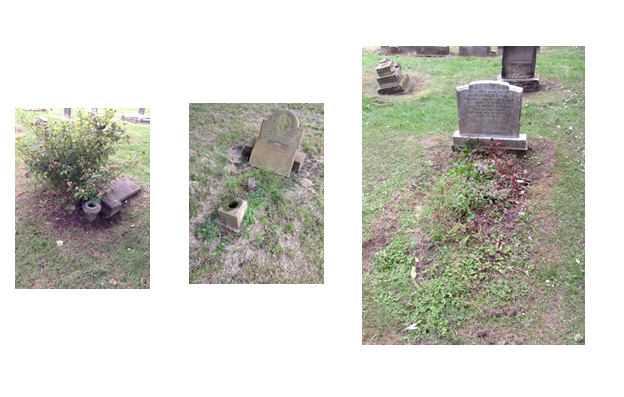
Although rather morbid, I found a strange phenomenon with some of the graves in the cemetery. Upon the spot where the deceased would have been buried, a bunch of wild flowers and plants had grown, as seen in the pictures. As horrible as it sounds, I believe that the nutrients and minerals from the decomposing body have given these wild plants nutrition to grow and sustain themselves in the middle of an area of mown grass. I had trouble deciding whether this was a biotic or abiotic factor, but decided to class it as biotic as the deceased human was once a living thing, and it is in our life cycle that we must return the nutrients that once sustained us back to where they belong. I believe this is an important factor in the sustain of this ecosystem, as the more the variety of plants, the more food sources available, and therefore more species are benefitted by their presence.
Abiotic factors included the presence of the dene. The dene was a running freshwater stream, which provided not only water to drink, but also a habitat for some animals and a food source for others. The dene provided water to support a wide variety of plants on its banks, which as I have mentioned before, support a large food web reaching into the cemetery and farmland. The variety of plants around the dene is a contrast to the farmland, as the farmland isn’t very far away, but is dominated by only one type of plant, due to human influences removing all other types of plant from the area so the barley has no competitors for resources, and so can grow bountifully.

Unfortunately, the area near the cemetery (i.e. the fields around it) is notorious in the local area for underage drinking. Young people from the nearby area are drawn to the secluded area to enjoy an illegal beverage. The influence of this action could be seen as I conducted my study. The amount of empty bottles, cans, packets and the rings that hold cans together was overwhelming. There are some obvious effects that can happen due to this, such as the rings from cans could potentially get caught around a bird’s neck, choking them to death. Any leftover or spilled alcohol could be consumed by a member of the ecosystem, and could be enough to kill them (as ethanol found in alcoholic drinks is toxic). Not to mention that the litter left behind decreases the aesthetic value of this otherwise beautiful area. These rowdy teenagers could also urinate or vomit into or around the dene, which could affect the wildlife nearby negatively. Also, the noise coming from the teenagers will be very loud I imagine, and so could disturb some of the animals trying to sleep or hunt at night.
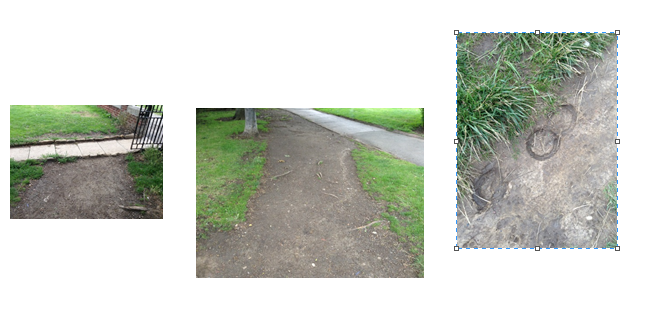
That isn’t the only part humans play in the development of how the ecosystem was when I conducted my study. This area of natural beauty is a favourite of the dog walkers and hikers of the area. This has had detrimental effects on the life, particularly plant life, living in the study area. Man-made paths had been made through areas of plants and grass, damaging places where new potential plants could have had a chance to grow. Also, the introduction of domestic cats, dogs and horses to the area could scare away animals that usually live there, and the introduction of a new predator (namely cats) could cause imbalance in the trophic levels of the disturbed food web. Also, the newly introduced species, for however briefly they may be in the area of study, they could introduce new diseases and infections to the population of animals and plants in the area. This could cause the removal of entire species from the area, as they might not be resistant to the new disease initially, and so cannot fend off the infection straight away. If the primary immune response is not enough, the disease could devour the population of that species before they have time to develop resistance to it. Therefore, the presence of humans and the animals they bring with them is mostly detrimental to the wildlife around the study area, unsurprisingly.
The last major abiotic factor I would like to mention is the impact of agriculture. To start off, the immediate effects of the farm are evident even by just looking at the farmland. The barley, like I have said throughout this study, dominates the landscape, not leaving many resources for other plants to use, therefore limiting the growth and nutrition of their competitors, allowing them to be more successful. Although this is advantageous to us humans, as we get more food, it negatively affects the plant life in the farmland (minus the crop) for obvious reasons such as the removal of other plants. This can cause ripple effects into an already established food web, yet again causing disturbance in the trophic levels. Another negative effect is the use of artificial pesticides and herbicides. Of course, there are the obvious effects, which will kill any pest or unwanted plant. However, there are greater effects that are often conveniently overlooked by farmers. These artificial chemicals can run into the nearby dene with the help of the rain, contaminating the water supply. This can have several effects. Any animals that drink from the dene will consume the harsh chemicals, causing them to fall ill or die. The plant life around the dene could be affected by the herbicides, killing them. The animals that live in the dene will be affected, possibly becoming sick or dying. The dene runs to the sea, and so animals in the sea could also be affected in the same way by the chemicals running with the stream. Such effects could severely harm not only the wildlife immediately in danger, but also the predators and their prey, as the numbers of different species fall.
To conclude, the abiotic and biotic effects of human influence have the biggest negative influence on the overall wellbeing of the ecosystem I chose to study. The insects and plants seem to work in harmony and in a mutualistic manner, both benefitting from the other’s presence. The differences of areas within my study area are what make this ecosystem so successful at providing a safe home for its many species among a metropolis of suburbs. Even though the human effects are prominent, the cemetery and dene seem pretty untouched, and although nothing can be done for the farmland, a new food web may develop due to the different species different crops bring into the area. Other than that, if there are no drastic changes to the cemetery, I can see the ecosystem surviving through the clutches of mankind, as a well-developed ecosystem should.
